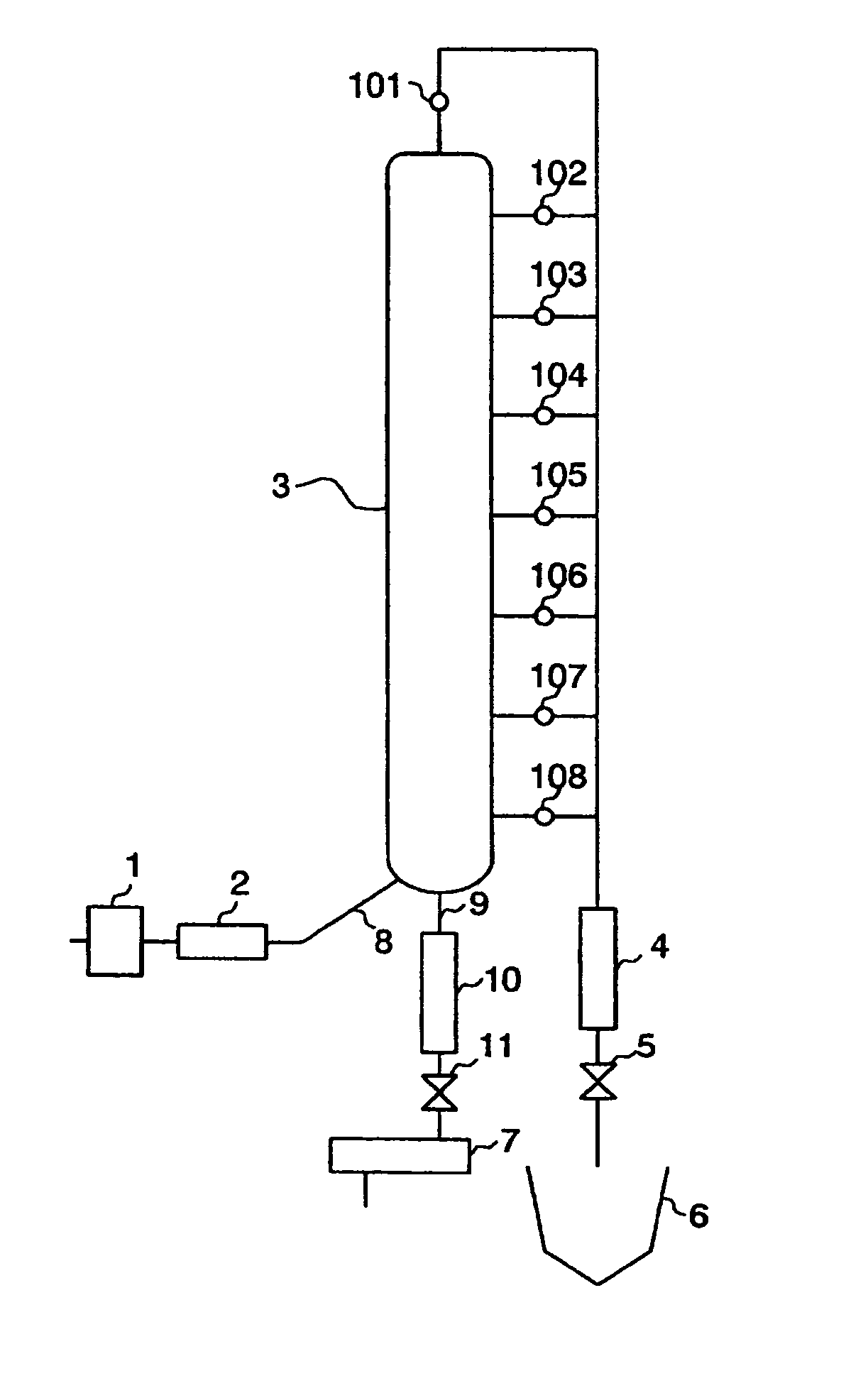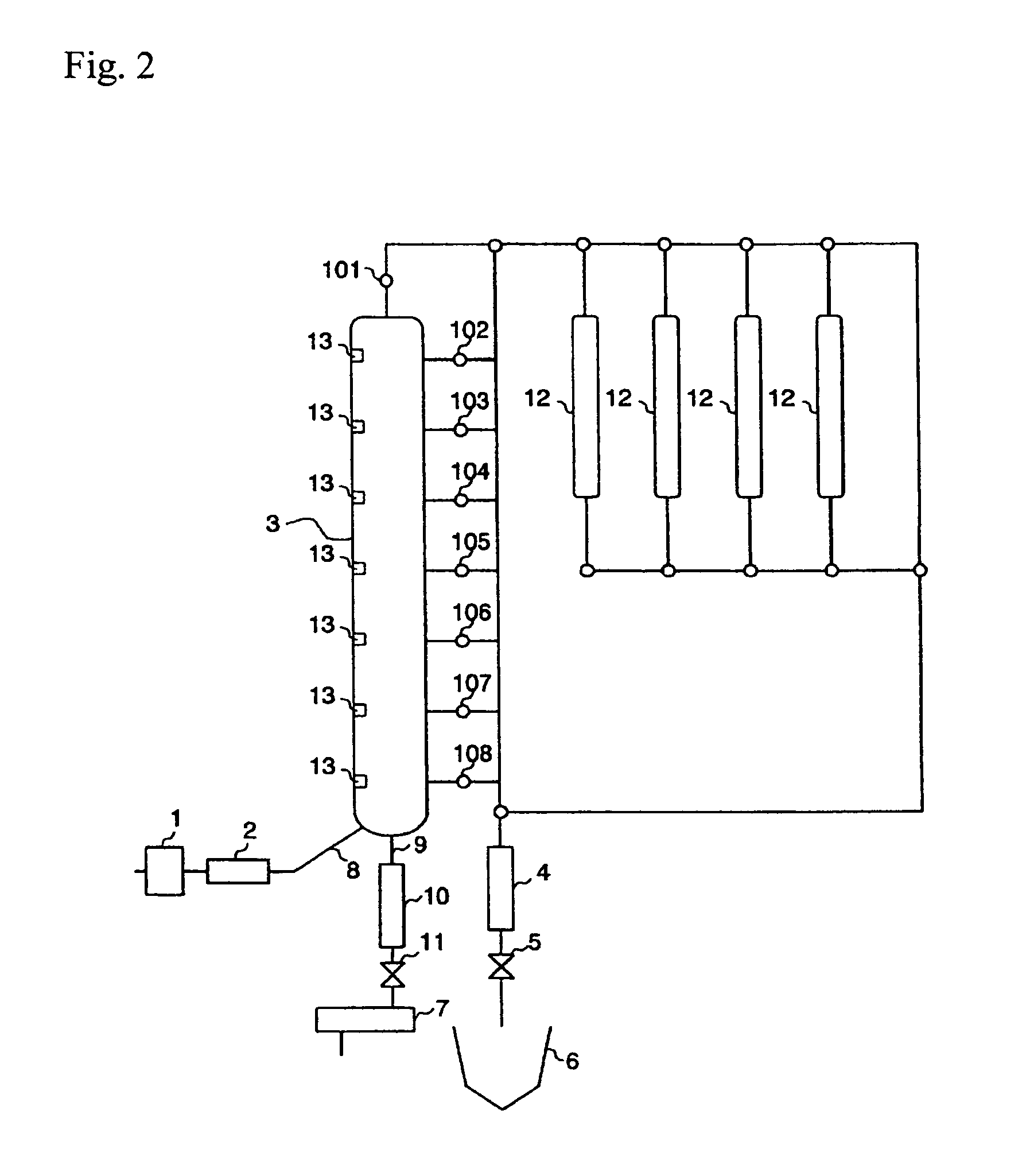Method of and apparatus for producing sub-critical water decomposition products
a technology of sub-critical water and decomposition products, which is applied in the direction of water, sludge treatment by oxidation, supercritical condition processes, etc., can solve the problems of reducing process efficiency, waste decomposition into carbon dioxide and water, and reducing process efficiency, so as to reduce equipment costs, reduce equipment costs, and control the decomposition reaction of the material to be processed
- Summary
- Abstract
- Description
- Claims
- Application Information
AI Technical Summary
Benefits of technology
Problems solved by technology
Method used
Image
Examples
embodiment 1
[0057]FIG. 1 is a schematic block diagram illustrating one example of the reaction apparatus according to Embodiment 1 of the present invention. As illustrated in this figure, this apparatus comprises a reactor 3, a compressing means 1, a heating means 2, a cooling pipe 4, a back-pressure valve 5, a reaction-completed-product recovery tank 6, and an effluent recovery tank 7. In the apparatus of FIG. 1, the compressing means 1 also serves as a mixture introducing means at the same time. The reactor 3 is of vertical type and in cylindrical tubular form, and is arranged substantially vertically. An inlet 8 and a discharge outlet 9 are provided at a bottom portion of the reactor 3. The compressing means 1 and the heating means 2 are connected to the just-mentioned inlet 8 by a piping. The inlet 8 is connected to the effluent recovery tank 7 via the cooling pipe and a back-pressure valve 11. The reactor 3 is provided with outlets on its head portion and its sidewall. In the example shown...
embodiment 2
[0085] In Embodiment 2, the reaction apparatus of Embodiment 1 is further provided with reactors for secondary reaction. FIG. 2 is a schematic block diagram for illustrating another embodiment of the apparatus for sub-critical water decomposition product according to the present invention. In FIG. 2, the same parts as those in FIG. 1 are designated by the same reference numerals. As illustrated in FIG. 2, the 12 are connected to the outlet 101 of the reactor 3 via pipes. The reactors for secondary reaction 12 are connected to one another via pipes. Each of the pipes are provided with a switching valve. The reactors for secondary reaction 12 can be freely connected either in series or in parallel with one another by switching with the valves. These reactors for secondary reaction 12 are connected to a cooling pipe by a pipe and further connected to a back-pressure valve 5. A reaction-completed-product recovery tank 6 is disposed following the back-pressure valve 5. In the example sho...
embodiment 3
[0095]FIG. 3 is a schematic block diagram for illustrating another example of the apparatus for sub-critical water decomposition treatment according to the present invention. In FIG. 3, the same parts as those shown in FIG. 1 are designated by the same reference numerals. As illustrated in FIG. 3, the apparatus of the present embodiment is provided with an outlet that is continuously movable along the flow direction of the sub-critical water in the reactor 3.
[0096] The movable outlet comprises a flexible pipe 14, an intake port 15 that is arranged at the fore-end of the flexible pipe 14, for taking in a desired sub-critical water dissolution part, a chain 16 for hanging the flexible pipe 14, and an intra-bath wheel 17 that is capable of winding up or reeling out the chain 16. By adjusting the length of the chain 16, the intake port 15 can be fixed to a desired position.
[0097] In the example shown in this figure, the flexible pipe 14 is configured to be inserted from the top end of...
PUM
| Property | Measurement | Unit |
|---|---|---|
| temperature | aaaaa | aaaaa |
| pore diameter | aaaaa | aaaaa |
| pressure | aaaaa | aaaaa |
Abstract
Description
Claims
Application Information
 Login to View More
Login to View More - R&D
- Intellectual Property
- Life Sciences
- Materials
- Tech Scout
- Unparalleled Data Quality
- Higher Quality Content
- 60% Fewer Hallucinations
Browse by: Latest US Patents, China's latest patents, Technical Efficacy Thesaurus, Application Domain, Technology Topic, Popular Technical Reports.
© 2025 PatSnap. All rights reserved.Legal|Privacy policy|Modern Slavery Act Transparency Statement|Sitemap|About US| Contact US: help@patsnap.com



